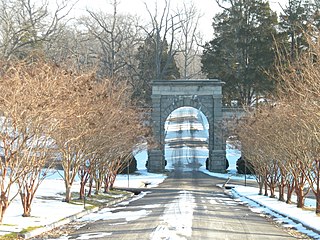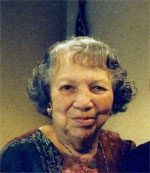
Arlington National Cemetery is one of two cemeteries in the United States National Cemetery System that are maintained by the United States Army. Nearly 400,000 people are buried in its 639 acres in Arlington, Virginia.

Lynchburg is an independent city in the Commonwealth of Virginia in the United States. First settled in 1757 by ferry owner John Lynch, the city's population was 79,009 at the 2020 census, making Lynchburg the 11th most populous city in Virginia. Located in the foothills of the Blue Ridge Mountains along the banks of the James River, Lynchburg is known as the "City of Seven Hills" or the "Hill City". In the 1860s, Lynchburg was the only city in Virginia that was not recaptured by the Union before the end of the American Civil War.

Lexington is an independent city in Virginia, United States. At the 2020 census, the population was 7,320. It is the county seat of Rockbridge County, although the two are separate jurisdictions, and is combined with it for statistical purposes by the Bureau of Economic Analysis. Lexington is about 57 miles (92 km) east of the West Virginia border and is about 50 miles (80 km) north of Roanoke, Virginia. First settled in 1778, Lexington is best known as the home of the Virginia Military Institute and Washington and Lee University.

Danville is an independent city in the Commonwealth of Virginia in the United States. The city is located in the Southside Virginia region and on the fall line of the Dan River. It was a center of tobacco production and was an area of Confederate activity during the American Civil War, due to its strategic location on the Richmond and Danville Railroad. In April 1865 it briefly served as the final capital of the Confederate States before its surrender later that year.

Bellefontaine Cemetery is a nonprofit, non-denominational cemetery and arboretum in St. Louis, Missouri. Founded in 1849 as a rural cemetery, Bellefontaine is home to a number of architecturally significant monuments and mausoleums such as the Louis Sullivan-designed Wainwright Tomb, which is listed on the National Register of Historic Places.

Hollywood Cemetery is a large, sprawling cemetery located next to Richmond, Virginia's, Oregon Hill neighborhood at 412 South Cherry Street. Characterized by rolling hills and winding paths overlooking the James River, it is the resting place of two United States Presidents, James Monroe and John Tyler, as well as the only Confederate States President, Jefferson Davis. It is also the resting place of 28 Confederate generals, more than any other cemetery in the country; these include George Pickett and J.E.B. Stuart.

Ota Benga was a Mbuti man, known for being featured in an exhibit at the 1904 Louisiana Purchase Exposition in St. Louis, Missouri, and as a human zoo exhibit in 1906 at the Bronx Zoo. Benga had been purchased from native African slave traders by the explorer Samuel Phillips Verner, a businessman searching for African people for the exhibition, who took him to the United States. While at the Bronx Zoo, Benga was allowed to walk the grounds before and after he was exhibited in the zoo's Monkey House. Benga was placed in a cage with an orangutan as a lampoon on Darwinism. To enhance the primitive image and presumably protect himself if need be from the ape, he was given a functional bow and arrow. He used this instead to shoot at visitors who mocked him and partially as a result of this the exhibition was ended. Except for a brief visit to Africa with Verner after the close of the St. Louis Fair, Benga lived in the United States, mostly in Virginia, for the rest of his life.

Blandford Cemetery is a historic cemetery located in Petersburg, Virginia. Although in recent years it has attained some notoriety for its large collection of more than 30,000 Confederate graves, it contains remains of people of all classes and races as well as veterans of every American war. It holds the largest mass grave of 30,000 Confederates killed in the Siege of Petersburg (1864–65) and other battles during the American Civil War. Although only 3,700 names of the interred are known, it was listed on the National Register of Historic Places in 1992, in part through the efforts of Charlotte Irving, first president of the Historic Blandford Cemetery Foundation. In addition to this cemetery's historic African American section discussed below, it is located adjacent to the People's Memorial Cemetery, a historic African-American cemetery, and small cemeteries containing additional dead from the lengthy Siege of Petersburg and Battle of the Crater in 1864.

The Virginia State Capitol is the seat of state government of the Commonwealth of Virginia, located in Richmond, the state capital. It houses the oldest elected legislative body in North America, the Virginia General Assembly, first established as the House of Burgesses in 1619.

Salisbury National Cemetery is a United States National Cemetery located in the city of Salisbury, in Rowan County, North Carolina. It was established at the site of burials of Union soldiers who died during the American Civil War while held at a Confederate prisoner of war camp at the site.

Carrie Allen McCray was an African-American writer.

The Anne Spencer House, in Lynchburg, Virginia, United States was, from 1903 to 1975, the home of Anne Spencer, a poet of the Harlem Renaissance. The house opened as a museum in 1977.

Magnolia Cemetery is a historic city cemetery located in Mobile, Alabama. Filled with many elaborate Victorian-era monuments, it spans more than 100 acres (40 ha). It served as Mobile's primary, and almost exclusive, burial place during the 19th century. It is the final resting place for many of Mobile's 19th- and early 20th-century citizens. The cemetery is roughly bounded by Frye Street to the north, Gayle Street to the east, and Ann Street to the west. Virginia Street originally formed the southern border before the cemetery was expanded and now cuts east–west through the center of the cemetery. Magnolia contains more than 80,000 burials and remains an active, though very limited, burial site today.

The Shockoe Hill Cemetery is a historic cemetery located on Shockoe Hill in Richmond, Virginia.

The City of London Cemetery and Crematorium is a cemetery and crematorium in the east of London. It is owned and operated by the City of London Corporation. It is designated Grade I on the Historic England National Register of Historic Parks and Gardens.

The Old Presbyterian Meeting House is a Christian church located at 321 South Fairfax Street in the Old Town neighborhood of Alexandria, Virginia. It is part of the National Capital Presbytery and the Synod of the Mid-Atlantic of the Presbyterian Church (USA).

The Contrabands and Freedmen Cemetery at 1001 S. Washington St. in Alexandria, Virginia was listed on the National Register of Historic Places on August 15, 2012. It was established in February 1864 by the Union military commander of the Alexandria District for use as a cemetery for the burial of African Americans who had escaped slavery, known as contrabands and freedmen. During early Reconstruction, it was operated by the Freedmen's Bureau. It was closed in late 1868, after Congress ended most operations of the Bureau. The last recorded burial was made in January 1869.
The Civil War Trust's Civil War Discovery Trail is a heritage tourism program that links more than 600 U.S. Civil War sites in more than 30 states. The program is one of the White House Millennium Council's sixteen flagship National Millennium Trails. Sites on the trail include battlefields, museums, historic sites, forts and cemeteries.
The African American Burial Ground is a historic cemetery for the enslaved, located in Ashburn, Virginia, off Harry Byrd Highway in Loudoun County, Virginia. Most of the enslaved buried there were from nearby Belmont Plantation.


























